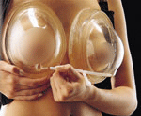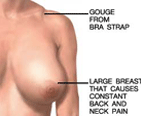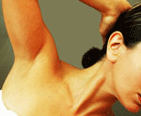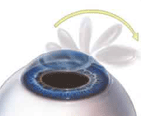 One of the most important functions of the breasts is breastfeeding. Therefore women, who wish and plan to have breast augmentation or any other breast surgery, are concerned whether they will be able to nurse their babies after the procedure or not. This ability after surgery depends upon various factors but the answer to the question is “yes” although you should be aware of all the possible complications and risks.
One of the most important functions of the breasts is breastfeeding. Therefore women, who wish and plan to have breast augmentation or any other breast surgery, are concerned whether they will be able to nurse their babies after the procedure or not. This ability after surgery depends upon various factors but the answer to the question is “yes” although you should be aware of all the possible complications and risks.
Firstly, there was a huge concern in the early 90’s with the reports of a so called silicone illness. People and professionals feared that silicone from the breast implants could leak into a mother’s milk and thus affect a baby’s health. However, later studies showed that there was no base to think so, since the silicone molecule was too small to get into the milk ducts.
Now most professionals use saline implants in breast augmentation surgery. They are said to be safe and have no harm to health. Even though there is no evidence that saline solution could pass into the milk ducts, there is no danger since this solution could not harm mother’s or baby’s health.
Some professionals claim that breastfeeding after the procedure could depend upon the type of the surgery and the incision site. Peri-aeroral, made around aerola, incision is believed to be the most risky of all. Nerves and vessels could be damaged during the surgery and then nursing and lactation would be affected. Therefore surgeons mostly choose to insert an implant through the incisions made under the fold of the breast, through the armpits or trans-umbilically (through the belly button) in order to escape possible troubles in baby nursing.
The effeciency of breast feeding
The efficiency of breast feeding depends very much upon the implant placement. Most breast implants are placed under the muscle so that the milk ducts would be not harmed during the surgery.
However, you should understand that breast augmentation is a surgical procedure, which, as any breast surgery, can affect the function of milk ducts. Studies have shown that any type of breast augmentation procedure affects lactation, independently from the incision site, type or placement of an implant. Specialists say that women, who have breast implants, are three times more likely to have insufficient milk supply.
Inadequate milk supply after breast surgery is explained due to the pressure of breast implants on the milk ducts, which then are not able to produce enough milk to nurse the baby. Another reason might be due to the surgery. During the procedure milk ducts can be damaged, especially through peri-aeroral incision, resulting in inadequate milk supply after pregnancy.
An additional problem is that women, who have breast implants , fear to nurse their babies because they somehow believe that breast implants are harmful to the babies. Some women avoid breastfeeding because they are afraid of possible complications due to breast implants. What you should know is that these fears are unreal and should be ignored. Besides, American Academy of Pediatrics state that breastfeeding is a preferred method to nurse the baby and therefore encourages women to breastfeed their babies.
In addition, please note that breast augmentation could result in certain complications, such as mastitis (infection of the milk ducts) and galactorrhea (milk production in a woman who is not pregnant). These complications are rare but you should be aware of them before having the surgery, since they could affect lactation and nursing.
Do not be afraid of breast augmentation surgery even though you still plan to have babies afterwards. Most likely breastfeeding problems are minor due to breast implants. But you should be informed and aware of them so that you can evaluate the ratio of risk and success of this particular procedure. And finally, do not forget to discuss these problems and your future breastfeeding plans with your doctor. With his/her help, you will be able to escape all possible risks and complications in the end.
 There is one more possibility to increase the breast without surgical help! It could be reached by wearing the Brava system 10 hours a day for 10 weeks. Women can grow their breasts by one cup or sometimes even more. This natural enhancement is the clinically proven method to enlarge and improve the shape of the breasts. The principle of BRAVA system is "tension induced tissue growth". The result is natural and beautiful breasts. The results are 99.5% permanent. It is especially popular choice among women who have breast-fed and want to fill and lift not good looking breasts; very athletic women who want to have more feminized bodies but are against the breast augmentation surgery, and a variety of women who want to enlarge their breasts for one cup size. BRAVA system alike a bra with two plastic domes that are connected to a suction device, that’s why most patients quickly get used to sleeping in it – because for women it is natural to wear a bra. The only disadvantage that BRAVA system has is a "long fix"; you maybe needed several months to see final results; so if you decided to try this system be ready for waiting and be patient.
There is one more possibility to increase the breast without surgical help! It could be reached by wearing the Brava system 10 hours a day for 10 weeks. Women can grow their breasts by one cup or sometimes even more. This natural enhancement is the clinically proven method to enlarge and improve the shape of the breasts. The principle of BRAVA system is "tension induced tissue growth". The result is natural and beautiful breasts. The results are 99.5% permanent. It is especially popular choice among women who have breast-fed and want to fill and lift not good looking breasts; very athletic women who want to have more feminized bodies but are against the breast augmentation surgery, and a variety of women who want to enlarge their breasts for one cup size. BRAVA system alike a bra with two plastic domes that are connected to a suction device, that’s why most patients quickly get used to sleeping in it – because for women it is natural to wear a bra. The only disadvantage that BRAVA system has is a "long fix"; you maybe needed several months to see final results; so if you decided to try this system be ready for waiting and be patient. Reduction mammaplasty is a safe procedure when performed by a qualified doctor. However, it is not a small and simple surgical procedure, and as any surgery, it has some uncertainty and risk. Bear in mind, that complications are rare but still possible.
Reduction mammaplasty is a safe procedure when performed by a qualified doctor. However, it is not a small and simple surgical procedure, and as any surgery, it has some uncertainty and risk. Bear in mind, that complications are rare but still possible.  There are various techniques of the procedure. Usually the surgeon makes a so-called anchor-shaped incision that is around the areola, and then moves down up to a natural fold underneath the breast. Then excess fat, glandular tissue and skin are removed. Then a surgeon moves the nipple with the areolar area (a darker area around the nipple) into a new position. Breasts are formed to have a new and better shape.
There are various techniques of the procedure. Usually the surgeon makes a so-called anchor-shaped incision that is around the areola, and then moves down up to a natural fold underneath the breast. Then excess fat, glandular tissue and skin are removed. Then a surgeon moves the nipple with the areolar area (a darker area around the nipple) into a new position. Breasts are formed to have a new and better shape.  People, who have unwanted hair in certain places of their body, know how frustrating it can be to choose the right method for hair removal. They are also aware of how much time and money it requires to get rid off unwanted hair. However, growing demand for good image and beautiful looks make people overcome all the trouble that hair removal brings. Fortunately, there are modern methods that people can choose to get rid off unwanted hair most probably for good.
People, who have unwanted hair in certain places of their body, know how frustrating it can be to choose the right method for hair removal. They are also aware of how much time and money it requires to get rid off unwanted hair. However, growing demand for good image and beautiful looks make people overcome all the trouble that hair removal brings. Fortunately, there are modern methods that people can choose to get rid off unwanted hair most probably for good. LASIK eye surgery is an outpatient procedure. It usually takes less than 30 minutes for each eye. Local anesthesia is given with the help of local anesthetic eyedrops that numb the eye so that it becomes insensitive to the surgery.
LASIK eye surgery is an outpatient procedure. It usually takes less than 30 minutes for each eye. Local anesthesia is given with the help of local anesthetic eyedrops that numb the eye so that it becomes insensitive to the surgery.  One of the most important functions of the breasts is breastfeeding. Therefore women, who wish and plan to have
One of the most important functions of the breasts is breastfeeding. Therefore women, who wish and plan to have  My name is Monica Lopez. In september of 2004 I had private surgery to the nose. I was advised that in two months the recovery should be complete.I then went back after two months with the facial area very swollen. I was told it could take up to six months and later on I was told it could be up to a year. As a result of this surgery I cannot breath properly through the nostrils, my face is still swollen, I’ve got strange headache that I’ve never had before, and the nose job is bad done.
My name is Monica Lopez. In september of 2004 I had private surgery to the nose. I was advised that in two months the recovery should be complete.I then went back after two months with the facial area very swollen. I was told it could take up to six months and later on I was told it could be up to a year. As a result of this surgery I cannot breath properly through the nostrils, my face is still swollen, I’ve got strange headache that I’ve never had before, and the nose job is bad done.  By removing excess fat and skin from lower and upper eyelids, eyelid surgery removes puffiness of upper lids and bags below the eyes. This causes you look rested, younger and alert. Eyelid surgery offers excellent results that are long-lasting or even permanent to most of the patients. However, hereditary or individual life-style factors may influence how long the results will last.
By removing excess fat and skin from lower and upper eyelids, eyelid surgery removes puffiness of upper lids and bags below the eyes. This causes you look rested, younger and alert. Eyelid surgery offers excellent results that are long-lasting or even permanent to most of the patients. However, hereditary or individual life-style factors may influence how long the results will last.